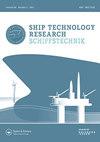A simplified welding simulation approach used to design a fatigue test specimen containing residual stresses
IF 0.9
Q3 ENGINEERING, MARINE
引用次数: 3
Abstract
ABSTRACT Although it is known that residual stresses may influence the fatigue strength of welded structures, they are usually not included explicitly in fatigue assessments. Experimental investigations on the influence welding residual stresses have on fatigue are complicated by the fact that small-scale specimens often show only little tensile residual stresses. In practice, residual stresses are usually not known and difficult to determine. Welding simulation approaches usually demand for experimental calibration making them unsuitable for residual stress predictions. The reliability of their results is however limited. Therefore, a welding simulation approach applying uniform temperatures without experimental calibration was proposed. Different input parameters were varied to determine their influence on the calculated residual stresses. The approach was then used to design a small-scale fatigue test specimen showing tensile residual stress at the weld. Specimens were produced based on the simulation results and residual stress measurements were compared to the calculated values.采用简化的焊接模拟方法设计含残余应力的疲劳试样
摘要尽管已知残余应力可能会影响焊接结构的疲劳强度,但它们通常不会明确包含在疲劳评估中。焊接残余应力对疲劳影响的实验研究很复杂,因为小尺寸试样通常只显示出很小的拉伸残余应力。在实践中,残余应力通常是未知的,并且难以确定。焊接模拟方法通常需要实验校准,这使得它们不适合于残余应力预测。然而,他们的结果的可靠性是有限的。因此,提出了一种应用均匀温度而无需实验校准的焊接模拟方法。改变不同的输入参数以确定它们对计算的残余应力的影响。然后,该方法被用于设计一个小规模的疲劳试样,显示焊缝处的拉伸残余应力。根据模拟结果制作试样,并将残余应力测量值与计算值进行比较。
本文章由计算机程序翻译,如有差异,请以英文原文为准。
求助全文
约1分钟内获得全文
求助全文

 求助内容:
求助内容: 应助结果提醒方式:
应助结果提醒方式:


